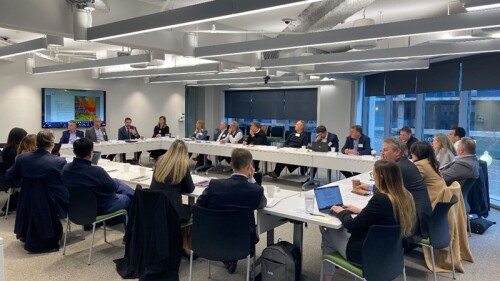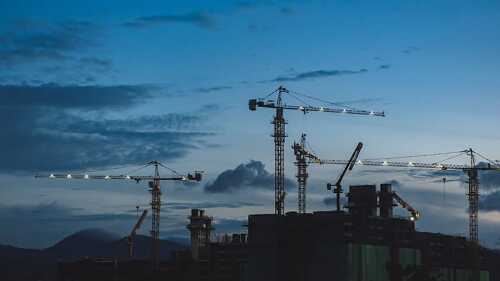Communities around the world are racing to control the spread of the novel coronavirus and the disease that it causes, COVID-19. Increasingly, that means implementing aggressive social distancing measures, which can inhibit the spread of the virus and flatten the transmission curve.
Governments have been shutting down schools, restaurants, large group gatherings, and other functions, and individuals have been limiting their interaction with other people.
Some functions, such as government operations, communications, pharmacies, and IT operations, still require essential personnel to report to government and commercial buildings, allowing the larger community to telework and function from their homes. Adoption of staggered work schedules with adequate physical spacing can help reduce the spread of infection, and building-management strategies can also be employed to mitigate the spread of disease.
Building Strategies
Given what is known about the virus so far, employing building strategies to help slow the spread of the disease makes sense to help protect those who must work in an office or commercial setting and in multifamily settings.
In the March 4, 2020, article in the New York Times, “Your Building Can Make You Sick or Keep You Well,” Joseph G. Allen, director of the Healthy Buildings program at Harvard T.H. Chan School of Public Health, wrote, “It turns out that while dense urban conditions can aid the spread of viral illness, buildings can also act as barriers to contamination. It’s a control strategy that is not getting the attention it deserves.”
Immediate, evidence-based preventative steps exist that people working in the real estate industry can take to reduce the chance of infection. Key building strategies include the following, according to the Center for Active Design and Lawrence Schoen, PE, principal engineer for Schoen Engineering in Columbia, Maryland, and chair of the committee that developed the ASHRAE “Position Document on Airborne Infectious Diseases":
- Continue to encourage hand washing: Health officials recommend washing hands often with soap and water for at least 20 seconds. Building managers should post signs encouraging hand washing and demonstrating effective washing techniques. Supply hand sanitizer. Hand washing is especially important after going to the bathroom, before eating, after blowing one’s nose, coughing, or sneezing.
- Strengthen cleaning: Implement an infection-control plan that includes regular disinfection of surfaces within buildings, including door handles, handrails, light switches, elevator buttons, restroom fixtures, shared keyboards, water fountains, other commonly touched items, and shared workspaces. Increase cleaning frequency; replenish cleaning supplies ahead of time; and ensure that bathrooms stay stocked with hand soap, hand sanitizer, paper towels, and facial tissue.
- Increase ventilation and reduce the number of people in the building: Ventilation with outdoor air is vital to diluting airborne contaminants and decreasing disease transmission rates. Many newer buildings reduce outside air to save energy (usually based on carbon dioxide levels.) The method is called demand-controlled ventilation (DCV). Such systems can be disabled during periods of concern. For buildings without heating and ventilation systems, another option is simply to open windows to let in more outdoor air. In addition, allowing people to telework or stay home reduces the population in a building, increasing ventilation per person for those who remain.
- Filter indoor air: Most urban buildings have central systems, and filter technology has advanced to fit better filtration into ordinary filter racks. Schoen recommends using the highest MERV filter available that fits in the filter rack and sealing the edges. On filtration, in the New York Times article, Allen said, “For buildings without mechanical ventilation systems, or if you want to supplement your building’s system in high-risk areas, portable air purifiers can also be effective at controlling airborne particle concentrations. Most high-quality portable air purifiers use HEPA [high-efficiency particulate air] filters, which capture 99.97 percent of particles.”
- Maintain optimal humidity: Evidence suggests that viruses survive better in low-humidity environments. Sources vary in recommendations for optimal humidity levels, but humidity levels of 30 to 40 percent at minimum are recommended. Higher humidity ranges of 40 to 60 percent, while potentially beneficial in the short term, can pose cause long-term maintenance challenges. Building operators can increase humidity through adjustment of heating and ventilation systems or by purchasing and installing portable humidifiers.
As the world confronts the coronavirus, Schoen says, “When it comes to this virus, we need all hands on deck. Prevention strategies like social distancing, telework and staggered schedules, and cleaning and disinfection are key. HVAC strategies are the icing on the cake.”
Experiences in Asia
Responding to the threat of the coronavirus in Asia and elsewhere, and as part of comprehensive virus-containment strategies orchestrated by governments, building owners and managers have been deploying extensive regimens to address the spread of the virus, including enhanced cleaning protocols, signage, and more. China was the first to identify and confront the virus, and experience in Asia offers some lessons for building owners and managers elsewhere.
In a March webinar produced by ULI Asia Pacific, now archived on Knowledge Finder, leaders of property investment, management, and development firm Hongkong Land shared some of the measures they have put in place in areas that are at high risk because of the level of disease spread and density. Those measure include:
- Employees and visitors to Hongkong Land buildings must don surgical masks before entering. This does not protect the wearer so much as it protects others if the person wearing the mask is unknowingly infected. It also helps remind the wearers not to touch their eyes, nose, and mouth.
- As part of national surveillance programs, thermal scans to check body temperature are performed on all tenants and visitors.
- People entering the building are asked about recent travel and may be denied entry to tenants’ premises for 14 days after their return from travel to severely affected areas.
Ventilation, Filtration, and Humidity
In addition to the measures described above, building owners and managers are consulting with heating, ventilation, and air conditioning experts for guidance on how their systems can be managed in response to the virus outbreak. Engineers who are familiar with a building’s equipment and local requirements can provide the best advice for specific situations.
Samuel Jiang, PE, a mechanical, electrical, and plumbing engineer with Skidmore, Owings, & Merrill (SOM), specializes in the urban environment and tall buildings and has worked on the 1,709-foot-tall (521 m) Guiyang Cultural Plaza Tower in Guizhou province, China, among other projects.
In an interview with Urban Land, Jiang discussed the importance of indoor humidity levels, noting that “viruses like flu and coronavirus spread through droplets when people cough or sneeze. When the humidity is higher, the droplets become heavier and fall to the surface, where they are easier to control.”
In addition, Jiang pointed out, dry air tends to dry out the moist mucus membranes in people’s upper respiratory system that trap harmful particles before they reach the lungs. “Breathing dry air makes people more susceptible to virus infection,” Jiang said. Furthermore, as Schoen notes, some but not all viruses and microorganisms have increased survival rates at low relative humidity.
Dr. Ben Schwegler, former chief scientist of the Walt Disney Company and managing director of Disney Research China, is a consulting professor of civil and environmental engineering at Stanford University. To understand building HVAC systems based on their resistance to virus transmission, he said, it is helpful to look at the spectrum of conventional commercial HVAC systems.
On one end of the spectrum is a hospital operating room, in which all air enters typically through ceiling vents, and all air leaves through vents near the floor. It then is forced through a HEPA filter and disinfected.
Toward the other end of the spectrum is the typical VAV (variable air volume) system, a type of HVAC system in which all the air in a room, zone, or building is mixed with a small volume of outdoor air and the mixture is run through non-HEPA filters. Many urban buildings use this type of system.
Jiang, the MEP engineer with SOM, noted that one way to help minimize virus transmission through VAV is to further open the outside air damper, allowing the system to operate with maximum outside air. But some systems, he pointed out, cannot be modified in this manner or do not have the heating or cooling capacity to do it and maintain comfort. Jiang also recommends using the highest-grade air filters possible and maintaining indoor humidity at 40 to 50 percent. Others suggest that a minimum of 30 percent can be beneficial.
Bob Pratt, managing director and co-head of global design and construction for Tishman Speyer in China, reported that his team is changing and cleaning air filters more frequently and looking at ways to modulate and maintain humidity in the 40 to 60 percent range.
Individual packaged terminal air conditioner (PTAC) systems are another type of HVAC system that serve a single room or small area. PTACs are found in many hotels, motels, apartments, and senior living facilities. They offer the advantage of containing air, along with any pathogens it might hold, to a single small area.
However, PTAC systems recirculate more “used” air and have less effective filtration. To ensure an adequate supply of fresh air, Jiang said, “since this system has so much less air exchange and it’s difficult to increase outside air volume, we would recommend opening windows for an hour or so before turning it on, if the outside air is not too cold.” Hot, humid outdoor air, and, in some cities, highly polluted outdoor air and noise, would make it impractical to open windows.
Ultraviolet Germicidal Irradiation
In addition to ventilation, filtration, and humidity-related strategies, ultraviolet germicidal irradiation (UVGI)—which uses short-wavelength ultraviolet light (UV-C) to kill or deactivate microorganisms—is an additional potential protective measure. UVGI can be used to destroy virus particles in HVAC filters and can be installed in the upper part of rooms for high-risk occupancies, like hospitals and schools.
ASHRAE, the global organization that publishes standards and guidelines for HVAC, recommends UVGI use in hospitals, schools, and military installations, but application in the United States has been limited. Not only is there the initial expense and need for professional installation, but these specialized systems require additional ongoing maintenance.
However, UVGI use to treat filters is recommended by Louie Cheng, director of the China chapter of the Indoor Air Quality Association and president of indoor environmental quality consultancy PureLiving Ltd, which operates in China, Hong Kong, and India. “We suggest, where possible, using high-efficiency (F9 or higher) filters to capture potentially virus-contaminated droplets, then shining UV-C light on the filter to inactivate viruses,” Cheng said.
Social distancing is the key priority now, and buildings have a role to play in global containment efforts. When it comes to buildings, local climate, air pollution levels, and policy all influence actions by building owners and operators. Strategies and government directives may shift with the prevalence of disease, density, and other factors. As the world confronts the coronavirus crisis, effective tools to fight its spread are essential.
Disclaimer: This article does not constitute medical advice.
ULI will be holding additional webinars on dealing with the COVID-19 challenge, with information available online and on Knowledge Finder, and has compiled information relevant to building owners at www.uli.org/covid19.
ULI members who would like to share their knowledge and concerns about dealing with the COVID-19 outbreak are invited to send their comments to [email protected]. Comments will help inform upcoming meeting topics and research at ULI.
RACHEL MacCLEERY is senior vice president at ULI; ELIZABETH RAZZI is editor in chief of Urban Land; BILLY GRAYSON is executive director of the ULI Center for Sustainability and Economic Performance; KEN RHEE is executive director of ULI China Mainland; and COLIN GALLOWAY is vice president for content, ULI Asia Pacific.
For More Information
World Health Organization, “Q&A on coronaviruses (COVID-19)”




